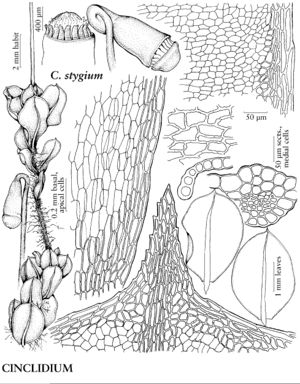Cinclidium
J. Bot. (Schrader) 1801(1): 27, plate 2. 1803.
| Taxon | Illustrator ⠉ | |
|---|---|---|
 | Cinclidium stygium | Patricia M. Eckel |
 | Cinclidium subrotundum | Patricia M. Eckel |
Plants 3–8 (–13) cm, in tufts or mats. Stems dark-brown or reddish-brown, erect, simple or branching distally, not dendroid; rhizoids dark-brown, macronemata often matted in longitudinal rows along stem, micronemata absent. Leaves green, yellowish green, reddish green, reddish-brown, or black when old, contorted when dry, spreading or erect-spreading, ± flat or reflexed to arcuate-recurved when moist, orbicular, spatulate, elliptic, ovate, ovatelanceolate, or obovate, 2–6 mm; base short-decurrent or occasionally not decurrent; margins recurved or rarely plane, green, brown, or reddish-brown, 1-stratose or 2-stratose, entire; apex acute, acuminate, obtuse, or rounded, rarely retuse, usually apiculate or rarely cuspidate, cusp usually toothed; costa percurrent or excurrent, occasionally subpercurrent or ending well before apex, distal abaxial surface smooth, abaxial stereid band present, U-shaped; medial laminal cells elongate, short-elongate, or ± isodiametric, 25–110 µm, in diagonal rows or not, not or weakly collenchymatous, walls pitted; marginal cells differentiated, short-linear or linear, in 2–4 rows. Specialized asexual reproduction absent. Sexual condition synoicous or dioicous. Seta single, yellowish, red, or reddish, 1.5–7 cm, flexuose. Capsule pendent, light or yellowish-brown, yellowish green, or light green, elliptic, ovate-elliptic, or subglobose, 1.5–3 mm; operculum hemispheric; exostome greenish yellow; endostome yellowbrown, segments fused into dome at apex. Spores 25–70 µm.
Distribution
North America, South America, Eurasia
Discussion
Species 4 (4 in the flora).
Cinclidium is most readily distinguished from similar genera in Mniaceae with entire leaf margins, in particular Rhizomnium, by the longitudinal rows of macronemata that extend up the stem and the costa having a U-shaped band of stereid cells (T. J. Koponen 1974). The fused, dome-shaped endostome, which is taller than the exostome, is also diagnostic for Cinclidium, although sporophytes are uncommon. G. S. Mogensen (1973) stressed that gametophytic variation is common in all of the species of Cinclidium, although a number of vegetative characters are useful in separating them. Cinclidium arcticum and C. latifolium have diploid sporophytes (n = 7), whereas C. stygium and C. subrotundum have tetraploid sporophytes (n = 14).
Selected References
None.
Key
| 1 | Leaves strongly reflexed to arcuate-recurved when moist. | Cinclidium latifolium |
| 1 | Leaves ± flat, not strongly reflexed when moist | > 2 |
| 2 | Leaves ovate, ovate-lanceolate, or narrowly elliptic, rarely obovate or orbicular; apices acuminate or acute; medial laminal cells short-elongate or ± isodiametric. | Cinclidium arcticum |
| 2 | Leaves broadly elliptic, ovate, spatulate, obovate, or ± orbicular; apices obtuse or rounded, sometimes acuminate or acute; medial laminal cells elongate | > 3 |
| 3 | Leaves broadly elliptic, ovate, obovate, or rarely ± orbicular; apices apiculate or cuspidate, apiculus sharp; margins 1-stratose; capsules ovate-elliptic. | Cinclidium stygium |
| 3 | Leaves broadly elliptic, ± orbicular, or spatulate, occasionally ovate or obovate; apices usually apiculate, apiculus blunt; margins 2- or 3-stratose; capsules subglobose. | Cinclidium subrotundum |